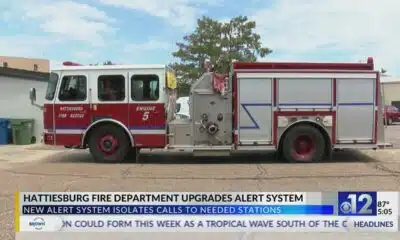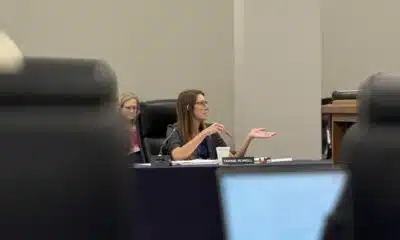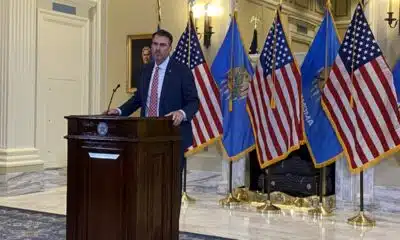News from the South - Alabama News Feed
Local law enforcement agencies in Alabama partner with ICE, sparking concerns
by Alander Rocha, Alabama Reflector
May 27, 2025
Local law enforcement agencies across Alabama are entering into agreements with U.S. Immigration and Customs Enforcement (ICE), a move that is drawing concern from immigrant communities and civil rights advocates.
At least nine such agreements with sheriff’s offices are active in six Alabama counties, with three more pending — two with county sheriff’s departments and one with a local police department. These agreements, known as 287(g) programs, deputize local officers to enforce federal immigration laws.
“(These) agreements basically give police the capability to do ICE’s job, ICE’s work, and the way the community sees it is police are now immigration officers. That’s the way it translates over to the community,” said Celsa Stallworth, a community organizer in Randolph County with the American Civil Liberties Union (ACLU) of Alabama.
GET THE MORNING HEADLINES.
Colbert, Crenshaw, Elmore, Etowah, Franklin and Henry counties have at least one agreement with ICE. The Houston County Sheriff’s Office and Level Plains Police Department in Dale County have pending agreements.
The 287(g) program, rooted in federal law, allows local law enforcement agencies to partner with ICE, granting designated state and local officers the authority to perform certain immigration enforcement functions. These agreements have existed for years but are seeing renewed interest and implementation, partly due to executive orders incentivizing states to cooperate with federal immigration efforts.
There are different models of 287(g) agreements. The “jail enforcement” model primarily allows local authorities to check the immigration status of individuals booked into county jails and place “ICE holds” on those found to be undocumented, typically for 48 hours, allowing ICE to take them into custody.
The “warrant service model” gives local law enforcement officers legal authority to execute civil immigration warrants for the ICE Enforcement and Removal Operations (ERO) office.
The “task force model” trains officers to act as immigration officers in the community, potentially extending enforcement beyond jails to community detentions. ICE describes it as a “force multiplier for law enforcement agencies.”
While a proponent said these partnerships are crucial for public safety and addressing immigration concerns, critics warn of potential civil rights violations, increased fear within immigrant communities, and a strain on community-police relations.
John Summers, chief of the Level Plains Police Department, a community with a population of about 1,800 in Dale County, is awaiting final approval of a “task force” agreement after an ERO official suggested it would be “a good alternative” to addressing immigration concerns on a local level. He said Level Plains has had a steady Latino population over the years, which he claims were mostly in the country without authorization, though it’s not possible to make that determination without the judicial system.
Level Plains has a Hispanic or Latino population of about 10.3%, according to the U.S. Census Bureau’s American Community Survey 2023 5-year average estimate. While the foreign-born population in Level Plains is unavailable, Dale County’s foreign-born population is 3.4%, under Alabama’s average of 3.8%.
“(It) gives us a little more give us a little more authority when it comes to dealing with illegals, and it gives us a better relationship with ICE directly,” Summers said.
But “foreign-born” doesn’t necessarily mean they are Latino or are living in the U.S. without authorization, said Allison Hamilton, executive director of the Alabama Coalition for Immigrant Justice. She said that poultry plants in the Enterprise and Dothan area employ migrants on work permits.
“We saw that people were coming into Alabama to work at those locations. In that area, for example, you’re going to have a lot of people who probably have a work permit, who could easily be detained due to outdated records or just a complete lack of knowledge,” Hamilton said.
Hamilton said these agreements, which give law enforcement “the responsibility of acting as immigration enforcement without the proper knowledge,” could have unintended consequences. She said that immigration law is complicated and that officers receiving basic training on immigration duties aren’t equipped to deal with complex immigration cases.
“If you have a very simplistic understanding, but you’re tasked with trying to enforce that (law), a lot of people who shouldn’t be detained are detained, and this often leads to civil rights violations, and can come back to the officers later as incorrectly enforcing the law,” Hamilton said.
Summers said the department will handle each case individually. He believes most immigrants in the community are “trying to do better for themselves,” but they “have to do it the right way,” saying that these agreements will help the department hold more people accountable.
“We treat everybody fair, and we want to help everybody we can help, legal or illegal, but I mean, at some point you’ve got to help yourself, and you’ve got to follow the rules that we have sworn to uphold,” Summers said.
When asked if immigrants, regardless of status, should feel less safe in communities with these agreements, Hamilton said that if government officials, presumably most trained in immigration law and federal enforcement, are currently detaining people with legal status, she expected that local police performing such duties would lead to even more mistakes.
“I think anybody who is an immigrant or who appears to be an immigrant needs to proceed with caution at this point when interacting with any law enforcement,” Hamilton said, adding that these agreements are damaging law enforcement’s ability to build relationships in immigrant communities.
Stallworth said the consequence of these agreements and increased ICE activity has been the fear created within immigrant communities, affecting both undocumented individuals and naturalized citizens with mixed-status families.
As a U.S.-born citizen who “looks Mexican,” she said, “I am fearful”. She fears for her naturalized mother, who speaks “broken English,” and for her husband, who may get caught up trying to “protect someone.” Stallworth said she had a conversation with a Latina woman in Shelby County who said she was concerned about everyday activities like picking up children from school or going grocery shopping.
“What we tell is that, make sure to follow the law when you’re driving. Make sure that your lights are working and things like that, because they have to continue living,” she said.
YOU MAKE OUR WORK POSSIBLE.
Alabama Reflector is part of States Newsroom, a nonprofit news network supported by grants and a coalition of donors as a 501c(3) public charity. Alabama Reflector maintains editorial independence. Contact Editor Brian Lyman for questions: info@alabamareflector.com.
The post Local law enforcement agencies in Alabama partner with ICE, sparking concerns appeared first on alabamareflector.com
Note: The following A.I. based commentary is not part of the original article, reproduced above, but is offered in the hopes that it will promote greater media literacy and critical thinking, by making any potential bias more visible to the reader –Staff Editor.
Political Bias Rating: Center-Left
This content presents a detailed examination of local law enforcement agreements with ICE in Alabama, highlighting concerns from immigrant communities and civil rights groups such as the ACLU. The article includes critical perspectives on the potential negative impacts of these programs on immigrant rights and community trust, while also incorporating viewpoints from law enforcement officials who defend the agreements as necessary for public safety and accountability. The overall tone and emphasis on social justice implications and immigrant protections suggest a center-left leaning perspective, focused on civil rights and cautious about aggressive immigration enforcement at the local level.
News from the South - Alabama News Feed
Judge to decide on evidence, video in Jabari Peoples' death by Friday
SUMMARY: A judge is expected to decide by Friday whether to review police body cam footage related to Jabari Peoples’ death. Peoples was fatally shot by a Homewood officer in June, with the death ruled justified. The family has seen portions of the video but not the full footage or a copy. Peoples’ mother’s legal team requested preservation of all evidence for potential wrongful death litigation. Concerns were raised about discrepancies between what the district attorney and the family observed in the video. Black Lives Matter protesters supported the family’s demand for transparency. The judge requested the investigating agency to submit all related videos for review.
Judge to decide on evidence, video in Jabari Peoples’ death by Friday
Subscribe to WVTM on YouTube now for more: https://bit.ly/2jvAaUD
Get more Birmingham news: http://www.wvtm13.com
Like us: https://www.facebook.com/WVTM13/
Follow us: https://twitter.com/WVTM13
Instagram: https://www.instagram.com/wvtm13/
News from the South - Alabama News Feed
Montgomery court grants temporary restraining order against AHSAA eligibility policy
by Andrea Tinker, Alabama Reflector
September 8, 2025
A state court Friday blocked an Alabama High School Athletic Association (AHSSA) policy barring transfer student-athletes from immediately participating in sports if they receive CHOOSE Act funds amid a lawsuit from Gov. Kay Ivey and Alabama House Speaker Nathaniel Ledbetter, R-Rainsville.
The CHOOSE Act is a voucher-like program that offers families up to $7,000 per qualifying child per year for “non-public education” expenses, including private school tuition. The program currently operates under income caps scheduled to be lifted next year.
The lawsuit, filed in Montgomery County Circuit Court, alleges AHSAA’s rules “specifically and unlawfully sideline CHOOSE Act students from AHSAA-sanctioned interscholastic athletic events for an entire year solely because they receive CHOOSE Act funds.”
“Every child deserves true choice in their education and that includes their right to participate in school athletics,” Ivey said in a statement Friday afternoon. “The court’s decision restores fairness to the process which is, of course, the very basis of the CHOOSE Act.”
A message seeking comment was left with AHSAA on Friday. The AHSAA considers the CHOOSE Act a form of financial aid similar to scholarships or tuition reductions, and it requires students who receive that to be ineligible for sports for one year. AHSAA said in a statement Thursday that the rule is in place to prevent students from having unfair advantages.
“This policy, established by our member schools, promotes competitive equity and deters recruitment,” the organization said in its statement.
When the act was initially introduced in 2024, there was no language about high school athletics. During House floor debate over the bill in February of that year, Rep. Joe Lovvorn, R-Auburn, introduced an amendment saying that “Nothing in this chapter shall affect or change the athletic eligibility of student athletes governed by the Alabama High School Athletic Association or similar association.”
The amendment was adopted on a 74-17 vote. The language remained in the final version of the bill.
Messages seeking comment were left Friday with Lovvorn.
Rep. Danny Garrett, R-Trussville, the sponsor of the CHOOSE Act and the chair of the House Ways and Means Education Committee, wrote in an email Friday that AHSAA was aware the governor and other politicians didn’t agree with the organization’s interpretation of the law.
“The Governor, Lieutenant Governor, Speaker of the House, the chief legislative legal officer and the bill sponsor have expressed the legislative intent of the CHOOSE Act during numerous conversations with AHSAA officials. The AHSAA’s position and response is obtuse, baffling and certainly not with the best interest of children and families in mind,” he wrote.
Ledbetter said in a statement Thursday AHSAA created the policy without getting clarification from policymakers which leaves families at a disadvantage, and implied that action from policymakers could be taken against AHSAA during the upcoming legislative session.
“For the AHSAA’s leadership to take such drastic action just as football season begins tells me they are not concerned with the best interests of all student-athletes.” the statement said. “While I fully expect members of the House and Senate will take a hard look at how the AHSAA operates in the upcoming session, this situation demands action today. My hope is the court will side with our student-athletes and not allow this organization to wrongfully take away their opportunity to compete.”
The AHSAA in 2016 altered its rules to allow homeschooled students to play sports in the public school districts in which they reside.
Alabama Reflector is part of States Newsroom, a nonprofit news network supported by grants and a coalition of donors as a 501c(3) public charity. Alabama Reflector maintains editorial independence. Contact Editor Brian Lyman for questions: info@alabamareflector.com.
The post Montgomery court grants temporary restraining order against AHSAA eligibility policy appeared first on alabamareflector.com
Note: The following A.I. based commentary is not part of the original article, reproduced above, but is offered in the hopes that it will promote greater media literacy and critical thinking, by making any potential bias more visible to the reader –Staff Editor.
Political Bias Rating: Center-Right
This content primarily focuses on a legislative and legal dispute involving a voucher-style education program (the CHOOSE Act) and its impact on high school athletics in Alabama. The CHOOSE Act, supported by prominent Republican figures like Gov. Kay Ivey and Alabama House Speaker Nathaniel Ledbetter, reflects a Center-Right position promoting school choice and private education funding. The article covers the controversy surrounding the Alabama High School Athletic Association’s eligibility rules, presenting statements from both sides without overt editorializing. The emphasis on school vouchers, legislative intent, and intervention to support families’ educational choices aligns with a Center-Right perspective typically associated with Republican policy priorities.
News from the South - Alabama News Feed
Cool mornings but hot afternoons ahead this week for Central Alabama
SUMMARY: Central Alabama will experience cool mornings with temperatures in the 50s and low 60s, warming up to hot afternoons throughout the week. Morning lows start around 56-64°F, including Birmingham at 59°F. Afternoon highs will reach the low to mid-80s in most areas, with some spots like Duncanville and Brent hitting the upper 80s. The week remains dry and comfortable, reminiscent of October weather, gradually warming to around 90°F by Thursday. The weekend will be hotter, with highs in the low 90s, ideal for home football games. Friday night will stay comfortable, with temperatures dropping to the 70s later in the evening.
Cool mornings but hot afternoons ahead this week for Central Alabama
Subscribe to WVTM on YouTube now for more: https://bit.ly/2jvAaUD
Get more Birmingham news: http://www.wvtm13.com
Like us: https://www.facebook.com/WVTM13/
Follow us: https://twitter.com/WVTM13
Instagram: https://www.instagram.com/wvtm13/
-
Mississippi Today6 days ago
Brandon residents want answers, guarantees about data center
-
News from the South - Texas News Feed5 days ago
Texas high school football scores for Thursday, Sept. 4
-
Our Mississippi Home6 days ago
Southern Miss Faculty and Student Contribute to Groundbreaking NOAA-Funded Plastic Cleanup
-
The Conversation6 days ago
AI is transforming weather forecasting − and that could be a game changer for farmers around the world
-
News from the South - Oklahoma News Feed7 days ago
Family sues Roblox, accusing them of failing to protect kids from predators
-
Mississippi News Video7 days ago
Hattiesburg Fire Department to implement new alert system
-
News from the South - Arkansas News Feed7 days ago
Arkansas correction division to enter settlement over disability law violations
-
News from the South - Oklahoma News Feed7 days ago
Thousands of State Employees Still Working Remotely









































